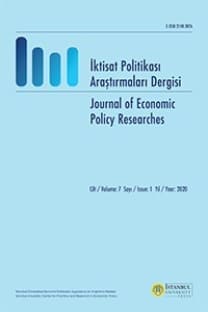Türkiye Cumhuriyet Merkez Bankası Para Politikasının Gecelik Repo Faiz Oranlarının Oynaklığı Üzerindeki Etkisi
Bu çalışmanın amacı 04.01.2010 ve 07.04.2014 dönemi arasında gecelik repo faiz oranlarının oynaklığını araştırmak ve böylece Türkiye Cumhuriyet Merkez Bankası’nın (TCMB) beklentileri yönetip yönetmediğini tespit etmektir. Çalışmada 2010-2014 dönemlerini kapsayan gecelik repo faiz oranları ele alınmış olup GARCH, EGARCH ve GJR-GARCH modelleri kullanılarak oynaklık araştırılmıştır. Yapılan modeller içerisinde gecelik repo faiz oranlarının oynaklığını açıklayan en uygun modelin EGARCH (1,1) modeli olduğu bulunmuştur. Analizden gerçekleşen durumların beklenen durumlardan daha etkili olduğu sonucu ortaya çıkmıştır. Yani kişilerin beklentileri gerçekleşmemiş ve bu durum oynaklığı artırmıştır. Gerçekleşen durumların beklentilere göre daha etkili olması Merkez Bankası’nın beklentileri yönetiyor olduğunun bir sonucudur.
Anahtar Kelimeler:
Faiz Oranları, Merkez Bankası, Zaman Serileri Modelleri, GARCH, EGARCH, GJR-GARCH
___
- Aklan N.A. ve Nargeleçekenler M. (2008). Para politikası faiz kararları ve uzun dönem faiz ilişkisi: Türkiye örneği. Marmara Üniversitesi İ.İ.B.F. Dergisi, XXV (2): 141- 163.
- Austin, Adrian ve Dutt, Swarna (2007). ARCH in Short Term Interest Rates: Case Study USA. Journal of Economics 40: 125-132.
- Bekaert G. ve Hodrick R.J. (2001). Expectations hypotheses tests. Journal of Finance, LVI (4): 1354-1394.
- Bollerslev, T. (1986). Generalized autoregressive conditional heteroskedasticity. Journal of Econometrics, 31: 307-327.
- Carpenter, Seth B.; Demiralp, Selva (2011); “Volatility, Money Market Rates And The Transmission Of Monetary Policy”, Finance and Economics Discussion Series Divisions of Research & Statistics and Monetary Affairs Federal Reserve Board, Washington, D.C.
- Christie, A.A. (1982). The stochastic behavior of common stock variances–value, leverage and interest rate effects. Journal of Financial Economics, 10: 407-432.
- Cocıuba, Miahi; Mutu, Simona; Dezsi, Eva; “Volatility Analysis Of The Overnight Interest Rates In Romania, Hungary And The Euro Zone”. http://doctorat2010.usv.ro/art_doctoranzi/104/Conf_Int_3_lucrare.pdf
- Dayioğlu, Tuğba (2012). Forecasting Overnight Interest Rates Volatility with Asymmetric GARCH Models. Journal of Applied Finance Banking 2(6): 151-162
- Engle, R. (1982). Autoregressive conditional heteroscedasticity with estimates of the variance of United Kingdom inflation. Econometrica, 50 (4): 987-1007.
- Fan, J. ve Yao, Q. (2003). Nonlinear time series: nonparametric and parametric methods. Springer published.
- Fisher I. (1930). The theory of interest, a determined by impatience to spread income and oppurtunity to invest it. New York: Macmillan Press.
- Fornari, Fabio (2005). The Rise and Fall of US Dollar Interest Rate Volatility: Evidence From Swaptions. Journal of Economics: 87-98
- Gençay, Ramazan ve Selçuk, Faruk (2006). Overnight Borrowing, Interest Rates and Extreme Value Theory. European Economic Review 50: 547-563
- Glosten, L., Jagannathan, R. ve Runkle, D. (1993). On the relation between the expected value and the volatility of the nominal excess return on stocks. The Journal of Finance, 48 (5): 1779-1801.
- Gradojevic, Nikola; Güney, Ramazan (2008). Overnight Interest Rates and Aggregate Market Expectations, Economic Letters 100: 27-30
- Hicks J. (1953). Value and capital. London: Oxford University Press.
- İnal D.G. (2006). Türkiye’de para politikası faiz kararlarının uzun dönemli faizler üzerindeki etkisi. Uzmanlık Yeterlilik Tezi. Türkiye Cumhuriyet Merkez Bankası, Dış İlişkiler Genel Müdürlüğü, Ankara.
- Keynes, J.M. (1930). A treatise on money. London: Macmillan Press.
- Kirchgassner, G. ve Wolters, J. (2007). Introduction to modern time series analysis. Berlin, Heidelberg: Springer Verlag.
- Kozicki, S. (1999). How useful are taylor rules for monetary policy. Economic Review, Federal Reserve Bank of Kansas City, Sayı: 84.
- Mazıbaş, M. (2005) “İMKB Piyasalarındaki Volatilitenin Modellenmesi Ve Öngörülmesi: Asimetrik Garch Modelleri İle Bir Uygulama” VII. Ulusal Ekonometri ve İstatistik Sempozyumu, 26 - 27 Mayıs, İstanbul.
- Nelson, D. (1991). Conditional heteroskedasticity in asset returns: a new approach. Econometrica, 59 (2): 347-370.
- Olweny, Tobias (2011). Modelling Volatility Of Short-Term Interest Rates In Kenya. International Journal of Business and Social Science, Vol 2, No 7, Special Issue-April 2011.
- Pagan, A.R. ve G. W. Schwert (1990). Alternative models for conditional stock volatility. Journal of Econometrics, Sayı:45, 267–290.
- Schwert, G.W. (1989). Why does stock market volatility change over time?. Journal of Finance, 44 (5): 1115-53.
- Taylor, J. (1993). Discretion versus policy rules in practise. Carnegie-Rochester Conference Series on Public Policy, Sayı: 32.
- Tsay, R.S. (2005). Analysis of financial time series. Wiley Intersience, Second Edition.
- Ullrich, K. (2003). A comparison between the fed and the ecb: taylor rules. Zew Discussion Paper, Centre for European Economic Research, Sayı: 03-19.
- Wang, P. (2007). Financial econometrics methods and models. London; New York: Routledge.
- Winkelmann, L., Bibinger M. ve Linzert T. (2013). ECB monetary surprises: identification through cojumps in interest rates. European Central Bank Economic Risk Discussion Paper, Sayı: 38.
- Zakoian, J.M. ve Francq, C. (2010). GARCH models: structure, istatistical inference and financial application. Wiley.
- Yayın Aralığı: Yılda 2 Sayı
- Başlangıç: 2014
- Yayıncı: İstanbul Üniversitesi
